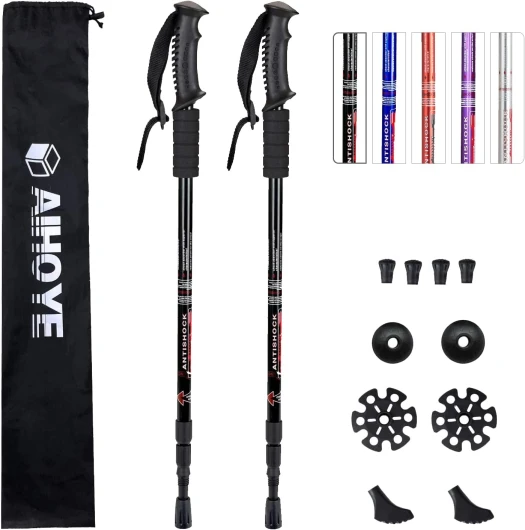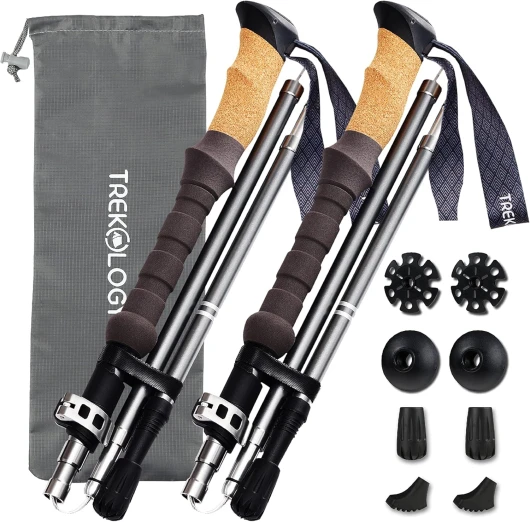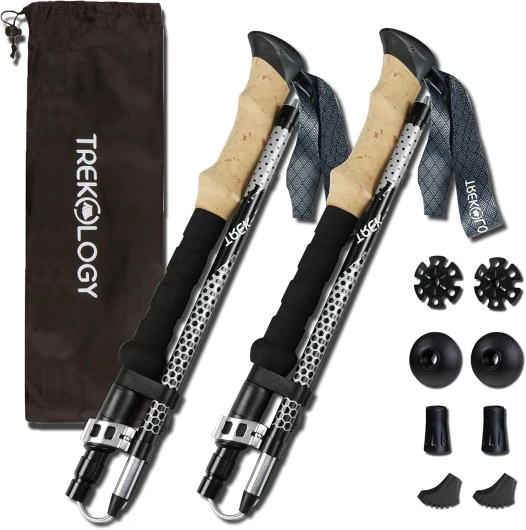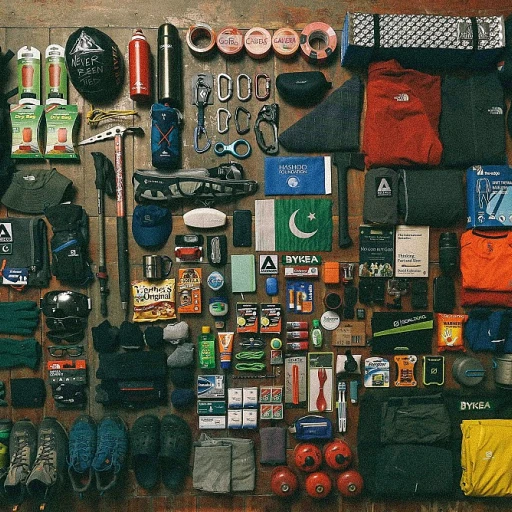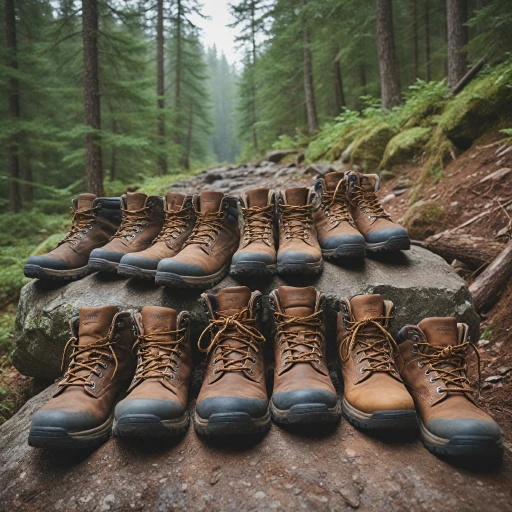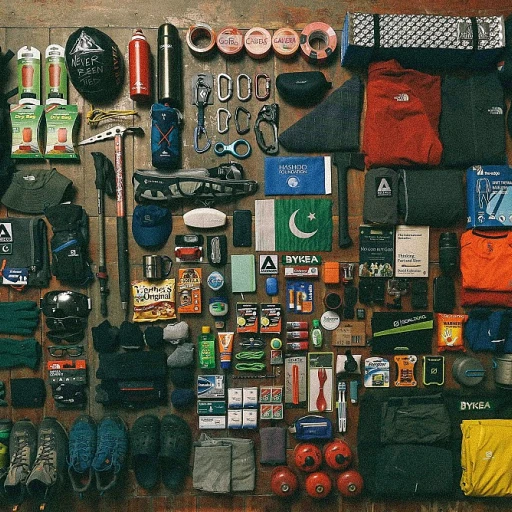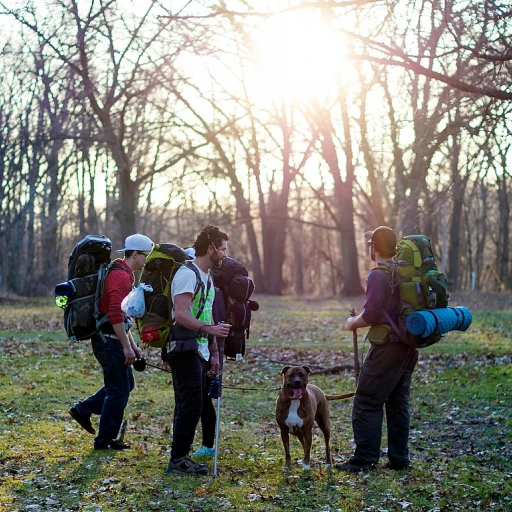
Understanding the Importance of Trekking Poles
The Role of Trekking Poles in Hiking
When it comes to hiking, trekking poles are more than just an accessory; they are a vital member of your gear ensemble. These poles provide stability and support, especially on uneven or challenging terrains. Whether you're navigating rocky paths or steep inclines, trekking poles can significantly reduce the strain on your knees and joints, making your hiking experience more enjoyable and less taxing.
Enhancing Balance and Stability
One of the primary benefits of using trekking poles is the enhanced balance they offer. By distributing your weight more evenly, poles help you maintain a steady grip on the trail, even on hard surfaces or slippery paths. This is particularly beneficial when you're carrying a heavy backpack, as the poles can help you keep your balance and prevent falls.
Reducing Impact on Joints
For those who hike regularly, the repetitive impact on joints can lead to discomfort or long-term issues. Trekking poles act as shock absorbers, reducing the impact on your knees and hips. This is especially important when descending, as the poles can take some of the load off your lower body, allowing you to hike longer without fatigue.
Versatility in Different Conditions
Trekking poles are versatile tools that can be adapted for various conditions. With the right tips, such as rubber tips for paved surfaces or carbide tips for rocky trails, you can ensure optimal performance. Additionally, snow baskets can be attached for winter hikes, providing extra support in snowy conditions. Understanding the importance of hiking stick handles can further enhance your trekking experience, offering comfort and control.
By integrating trekking poles into your hiking routine, you not only improve your stability and comfort but also extend the longevity of your hiking adventures. As you explore the other sections of this guide, you'll find tips on choosing the right poles, mastering techniques, and maintaining your gear for optimal performance.
Choosing the Right Trekking Poles for Your Needs
Understanding Different Types of Trekking Poles
Choosing the right trekking poles can significantly enhance your hiking experience, providing balance and reducing the strain on your joints. To ensure you make a well-informed decision, consider a few key factors.
Material Matters: Trekking poles are typically made from aluminum or carbon fiber. Aluminum poles are known for their durability and affordability, while carbon fiber poles offer a lighter weight and might be the better option for long-distance trekkers, although they can be more expensive.
Adjustability is Key: Adjustable poles allow for versatility, accommodating different terrains and inclines. Telescoping poles are particularly useful, providing flexibility. It’s important to ensure that the adjustment mechanisms are easy to use and reliable.
Handle Comfort: The grip of your trekking pole is crucial for comfort during long hikes. Handles come in various materials like cork, foam, or rubber, each offering different levels of comfort and sweat absorption. Trying them out can help you find the best option for your needs.
Tip Considerations: Trekking pole tips often come in carbide or rubber, designed for varying surfaces. Rubber tips are ideal for paved surfaces, hard surfaces, and reduce noise. On the other hand, carbide tips offer excellent grip on softer terrains.
Security Straps: Straps offer added security, enabling you to relax your grip without losing control of the pole. They should be adjustable and comfortable to prevent chafing.
Snow Baskets and Other Attachments: For winter conditions or snow-covered trails, consider poles with snow baskets. These attachments minimize the risk of your pole sinking too deep. Many poles also offer interchangeable baskets, allowing you to adapt them to different environments.
With a wide range of options available, taking the time to understand these factors can make a significant difference. And for further insight on how to elevate your hiking adventures, you might find this enhancing your hiking experience with a walking staff guide beneficial.
Proper Techniques for Using Trekking Poles
Mastering Your Walking Technique with Trekking Poles
Utilizing trekking poles effectively can greatly enhance your hiking experience. A good technique not only improves your stability but also increases your hiking efficiency. When using trekking poles, consider these tips to maximize their benefits:
- Adjust Your Grip: Start by holding the trekking poles comfortably. Use the pole straps correctly to support your wrists and allow a light grip on the handles, which can reduce fatigue over time.
- Synchronize Your Steps: Coordinate your movements so the opposite pole and foot work together. For example, if your right foot steps forward, your left pole should move in tandem.
- Manage Terrain Variations: For uphill hikes, shorten your poles to allow a natural arm angle and push off for extra power. When descending, lengthen the poles to enhance stability. Adjusting for terrain might sometimes mean switching your poles’ baskets for better performance on snow or mud.
- Adapt to Surface Types: Use rubber tips on hard surfaces like rocks or paved paths to ensure a secure grip and reduce impact noise. For dirt trails, remove the rubber tips to allow the metal tips or carbide tips to dig into the ground more effectively.
- Leverage Your Body Weight: Lean into the poles as you walk, using your upper body to help propel you forward. This technique not only conserves energy but also distributes the effort across different muscle groups, increasing overall endurance.
By implementing these strategies, your trekking poles will serve as a valuable member of your hiking gear collection, providing support exactly where and when you need it. Remember, careful upkeep of your trekking gear, including regular inspection and potential replacement tips, can prolong their lifespan and reliability, ensuring that your trekking adventures remain enjoyable and safe.
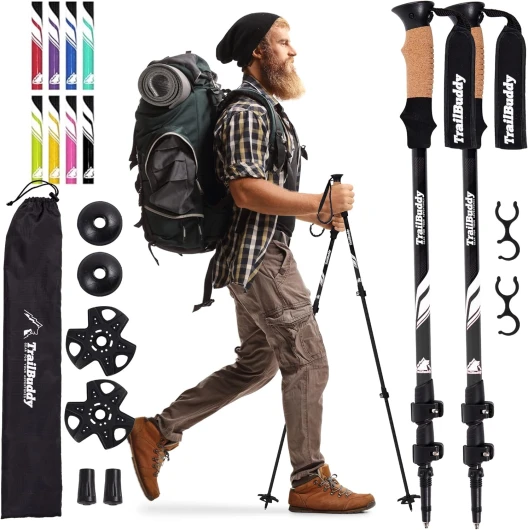
- + Lightweight design for easy carrying
- + Collapsible for space-saving storage
- + Made of durable 7075 aluminum
- + Comfortable cork grip for better handling
- + Includes a pair of 2 poles for balanced support
Maintaining Your Trekking Poles
Essential Care and Maintenance for Trekking Poles
To ensure that your trekking poles serve you well over a long period, regular maintenance is key. Just like essential hiking gear, such as your hiking boots, consistent care for your poles can make a significant difference. Here are some effective tips to keep your walking sticks in top condition:
- Cleaning Your Poles: After every hike, it’s important to clean your trekking poles, especially if they've been exposed to mud or sand. Use a damp cloth to wipe down the shafts and make sure to dry them thoroughly to prevent rust and wear.
- Inspecting for Damage: Regularly check for any signs of damage, such as dents or cracks in the shafts, and pay close attention to the locking mechanisms. Damaged walking poles may compromise your safety and efficiency when hiking.
- Securing the Pole Tips: Examine the rubber tips and carbide tips for wear. Whether you're using them on hard surfaces or rough trails, replacing them in time will help maintain good grip and prolong the life of your poles.
- Adjusting the Length: Ensure that the poles are adjusted to the correct length for your walking style and terrain, providing stability and minimizing strain on your body. Proper adjustment helps you use your poles hiking efficiently and keeps your hiking experience comfortable.
- Storage Considerations: When not in use, store your trekking poles in a cool, dry place. Avoid leaving them in direct sunlight or high temperatures, as the materials can become brittle or warp.
- Refreshing Parts: Consider keeping a set of replacement tips and additional snow baskets handy, as they wear out over time, especially on rugged trails or harsh weather conditions. Baskets can be important when trekking in snow, avoiding any hindrance to your stability.
Common Mistakes to Avoid with Trekking Poles
Avoiding Common Pitfalls with Trekking Poles
When you're out on the trail, making sure you're using your trekking poles effectively can enhance your hiking experience and keep you safe. However, many hikers inadvertently make a few missteps. Avoid these common mistakes to ensure your poles are doing the hard work for you:- Not Using the Correct Tips: Switching between carbide tips and rubber tips on your walking poles can greatly impact your grip, especially on varied terrain such as snow, paved surfaces, and hard surfaces. Use metal tips for ice and rough terrain, while rubber feet or rubber tips are ideal for paved trails.
- Ignoring Your Grip: Gripping your trekking pole too tightly can tire your hands and cause strain. Instead, let your wrist straps do the job. They should serve as a support so you can relax your grip while still maintaining control.
- Basket Neglect: It's easy to overlook those little baskets at the end of your poles. However, these are crucial when trekking in snow or mud. Make sure to attach snow baskets when needed, as they prevent your pole from sinking too deep.
- Improper Pole Height: Adjust your hiking poles so your elbow is at a 90-degree angle when holding the pole. This not only ensures effective use of the poles hiking but also prevents unnecessary strain on your muscles.
- Lack of Maintenance: Don't forget that maintaining your gear is a good practice. Regularly inspect your trekking pole for wear and tear, especially the pole tips and grips. Replacement tips and baskets can vastly improve the longevity of your poles.
- Over-Reliance: While trekking poles can be a fantastic aid, it's important to use them as intended. They're a tool to support your entire hiking experience, not a crutch. Developing good walking skills without poles will make you a more versatile hiker.
Integrating Trekking Poles with Hiking Boots
Maximizing Trekking Poles in Conjunction with Hiking Boots
Integrating trekking poles with your hiking boots can significantly enhance your hiking experience, improving stability and reducing strain on your joints. Here are some pointers on how to effectively combine these essential gear components:- Enhance Stability: When using trekking poles with your hiking boots, the synergy they create helps maintain balance on challenging terrains. If you're on rocky or uneven surfaces, the poles act as an additional support member that prevents slips and falls.
- Optimize Grip: Ensuring your trekking poles have suitable tips is crucial, especially for hard surfaces such as paved paths. Rubber tips or hard plastic ones can provide a better grip, preventing unnecessary slips. For dirt trails or snow, consider using pole tips that match those conditions, such as carbide tips for hard packed trails and snow baskets for wintry terrains.
- Synchronized Movements: Effectively using trekking poles requires proper technique in synchronization with your walking rhythm. This will not only improve your momentum but also ensure your energy is efficiently used, which can make a significant difference in endurance over time.
- Minimize Wear: Hiking boots and trekking poles often bear the brunt of tough walks. Keep an eye on the condition of your poles, especially the rubber feet and replacement tips, just as you would for the soles of your hiking boots. Ensuring they're in good condition will prevent unexpected breaks and extend their lifespan.

